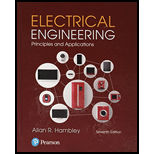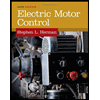
Pearson eText for Electrical Engineering: Principles & Applications -- Instant Access (Pearson+)
7th Edition
ISBN: 9780137562855
Author: Allan Hambley
Publisher: PEARSON+
expand_more
expand_more
format_list_bulleted
Concept explainers
Question
error_outline
This textbook solution is under construction.
Students have asked these similar questions
I need immediate help with my SIMULINK model. I don't know why but no matter how much a increase or decrease Kc or TI, the graphs are the same. C'A0(s) is the disturbance going through G'D(s). Please check my transfer function blocks by taking the laplace transform of the equations. Any suggestions is welcome greatly! thanks
P 4.4-22 Determine the values of the node voltages V1, V2, and
v3 for the circuit shown in Figure P 4.4-22.
202
ww
4ia
202
w
+
+
±12 V
V₁
ΖΩ
V2
ΖΩ
V3
11 A
+
하
3. An inifinite sheet of charge density of 3 nC/m² is located at x=-1m. An infinite line of charge
density 1 nC/m is parallel to the the z-axis and intersect the y-axis at y=-1m. (a) What is the
electric field vector at (0, 0, 0), assuming & = ε0? (b) What is the region in space
where the field is zero?
Knowledge Booster
Learn more about
Need a deep-dive on the concept behind this application? Look no further. Learn more about this topic, electrical-engineering and related others by exploring similar questions and additional content below.Similar questions
- Find the valve of voltage Vx using SUPERPOSITION 1 M FA www 4 5 M MAA 12V - $10 33 M 23 +x mn 6 8Aarrow_forwardFind the Valve of Voltage Vy using SUPERPOSITION الله 8 ZV ДАДА 6 5 ча 4 w 3 1 mm 2A MWarrow_forwardFind the value of voltage Using SUPER POSITION. GV www 6 M 33 ww ЧА 5. 123 AM 4 4 ۱۹۷arrow_forward
- Please explain in detail. I am most confused on how to get the transfer functions. thank youarrow_forwardPlease explain step by step in detail. I am most confused about the table. Thank youarrow_forwardUsing the block diagram or solution, show that the expected gain in the transfer function CA' (s)/Q'(s) is negative. Please explain how to approach this. No typed answers where the equation is in one line and it's hard to understand, please дома dela 1 C_AO G2(s) G3(5) dCA(t) dt dT' (t) dt = 2 Q beta 3-a G1(s) G4(s) (-AHko E koe RT + EKOČA RT2 E e E F T' (t) + Co (t) E 1 (All) (- -)+(y) = pcp eRT CA(t) + Е КОСАДНЕ PCPRT2 eRT T'(t) + Q'(t) 2 Tarrow_forward
arrow_back_ios
SEE MORE QUESTIONS
arrow_forward_ios
Recommended textbooks for you

 Electricity for Refrigeration, Heating, and Air C...Mechanical EngineeringISBN:9781337399128Author:Russell E. SmithPublisher:Cengage Learning
Electricity for Refrigeration, Heating, and Air C...Mechanical EngineeringISBN:9781337399128Author:Russell E. SmithPublisher:Cengage Learning Delmar's Standard Textbook Of ElectricityElectrical EngineeringISBN:9781337900348Author:Stephen L. HermanPublisher:Cengage Learning
Delmar's Standard Textbook Of ElectricityElectrical EngineeringISBN:9781337900348Author:Stephen L. HermanPublisher:Cengage Learning


Electricity for Refrigeration, Heating, and Air C...
Mechanical Engineering
ISBN:9781337399128
Author:Russell E. Smith
Publisher:Cengage Learning

Delmar's Standard Textbook Of Electricity
Electrical Engineering
ISBN:9781337900348
Author:Stephen L. Herman
Publisher:Cengage Learning
Diodes Explained - The basics how diodes work working principle pn junction; Author: The Engineering Mindset;https://www.youtube.com/watch?v=Fwj_d3uO5g8;License: Standard Youtube License